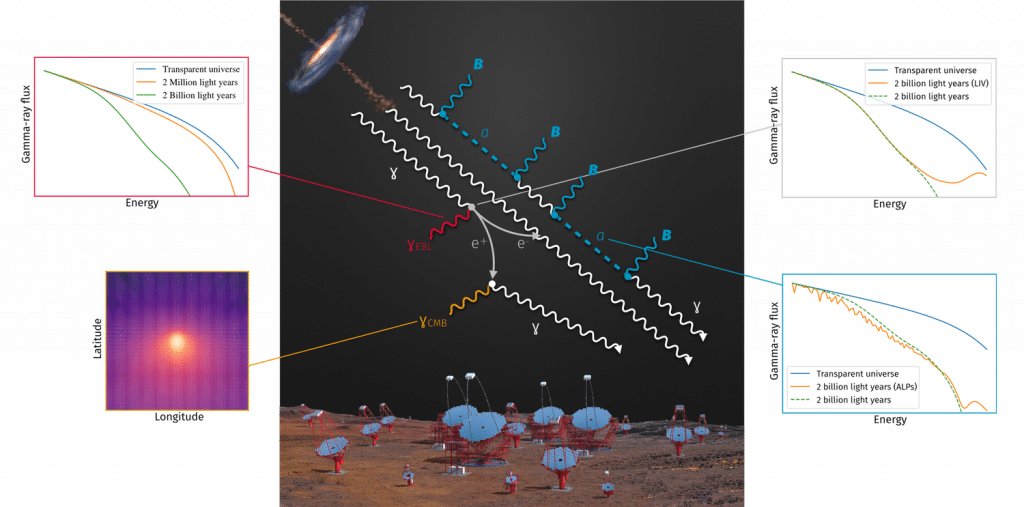Written by: Jonathan Biteau and Manuel Meyer
Photons at energies beyond a billion times that of X-rays cannot reach us from the outer edges of the observable Universe. Only a fraction of these very-high-energy gamma rays reach our atmosphere to produce firework-like visual displays called air showers. While our eyes can’t see these rapid air showers, telescopes can. Today, the H.E.S.S., MAGIC, and VERITAS telescopes observe gamma rays and tell us the story of their travels, taking nano-second pictures of the fireworks they initiate in the atmosphere. In the not-too-distant future, CTA will measure these gamma rays with its improved sensitivity and will write down the chronicles of gamma-ray propagation on cosmological scales.

Fig. 1: Cosmic journey of gamma rays from a distant galaxy down to the CTA Observatory. Some gamma rays produce electron-positron pairs when interacting with EBL photons (red). The pairs, deflected by the intergalactic magnetic field, scatter off CMB photons resulting in a gamma-ray halo (orange). Exotic processes such as Lorentz invariance violation (gray) or coupling to axion-like particles (light blue) could modify the absorption, resulting in characteristic spectral features.
Gamma rays are emitted in distant galaxies located billions of light years away. The chief foe that gamma rays face in the intergalactic medium is the army of lower-energy photons called the extragalactic background light (EBL). The EBL radiation spans the ultraviolet, optical and infrared bands and is created mainly by stars and dust in galaxies over the history of the Universe. EBL photons interact with gamma rays to generate pairs of electrons and positrons. This absorption, depicted in Fig. 1 (red box), becomes stronger with increasing gamma-ray energy and source distance. By measuring it in gamma-ray spectra of extragalactic sources, CTA will probe with unrivaled accuracy the spectrum and evolution of the EBL, thereby unveiling the formation and evolution of dust and stars in galaxies.
The electrons and positrons produced in the interaction with EBL photons do not reach Earth, however, they can scatter off photons of the cosmic microwave background (CMB). This transfers energy from the pairs to the CMB photons, transforming them to gamma rays with lower energies than that of the initial parent gamma ray, as shown in Fig. 1 (orange box). Because electrons and positrons are charged particles, they are affected by the intergalactic magnetic field in cosmic voids, which deflects their trajectory on scales of millions of light years. This creates a diffuse gamma-ray halo around otherwise point-like sources. CTA will search for such halos, and possibly detect for the first time the elusive remnant of cosmic magnetism in the most rarefied corners of the Universe.
In their struggle for survival, gamma rays could be helped by new processes, which lie beyond the standard models of particle physics and cosmology. The first is Lorentz invariance violation (LIV) at the Planck scale, the frontier of current physical theories. This process could shield gamma rays from interacting with the EBL, resulting in an unexpectedly large number of cosmic-trotters reaching Earth at the highest energies probed by CTA (Fig. 1, gray box). The second is a cloak called an axion-like particle. Gamma rays could put this cloak on within magnetic fields, effectively escaping interactions with the EBL. Cloaked-uncloaked oscillations (Fig. 1, light blue box) would result in larger-than-expected fluctuations in the gamma-ray spectra, which CTA will constrain with its excellent energy reconstruction.
Gamma rays from extragalactic sources tell us the story of an epic cosmic journey, probing the very fabric and content of the Universe in large voids. A first report of the potential of CTA to constrain gamma-ray propagation can be found in [1], but the CTA Consortium is actively preparing the scientific machinery to greet cosmic-trotters and recount their odyssey.
[1] Studying cosmological gamma-ray propagation with the Cherenkov Telescope Array, F. Gaté, R. Alves Batista, J. Biteau, J. Lefaucheur, S. Mangano, M. Meyer, Q. Piel, S. Pita, D. Sanchez, I. Vovk (for the CTA Consortium), ICRC proceedings (2017).